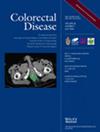Long-term outcomes of ‘temporary’ defunctioning in patients with severe perianal Crohn's disease
Abstract
Aim
This study aimed to analyse long-term outcomes in patients undergoing temporary faecal diversion for therapy-refractory Crohn's perianal fistulas.
Methods
In this retrospective study, Crohn's patients who underwent defunctioning for perianal disease between 2012 and 2022 were included. The primary endpoints were successful ostomy reversal and proctectomy/proctocolectomy rates. Secondary endpoints were clinical fistula closure, development of proximal colonic disease recurrence, and the influence of medication, patient and disease characteristics on ostomy reversal.
Results
In total, 53 patients were included, 35 colostomies and 18 ileostomies. Previous L2 disease was more frequently seen in the ileostomy group (colostomy 29%, ileostomy 83%; P = 0.004). Clinical closure of the fistula was seen in 26%. 21% (11/53 patients) underwent an attempt at ostomy reversal during a median overall follow-up of 90.1 months (interquartile range 17.5–82.5) of which nine ostomies (colostomy 23%, ileostomy 6%; P = 0.244) were closed successfully. In 35%, a proctectomy/proctocolectomy was required to control ongoing perianal sepsis. Factors associated with ostomy reversal were fistula closure (P < 0.001) and L1/L3 disease (P = 0.043). In patients with ostomy reversal attempt (n = 11), successful reversal was associated with colostomy (P = 0.055) and use of anti-tumour necrosis factor (anti-TNF) (P = 0.055) despite being previously classified as anti-TNF refractory.
Conclusion
Ostomy reversal rates are low, so defunctioning ostomies should be carefully considered because in most patients the ostomy will be permanent. In one-third of the patients, a proctectomy/proctocolectomy is required to treat ongoing perianal sepsis. If a patient is eligible for ostomy reversal, reversal should preferably be done under anti-TNF to optimize chances of success.


 求助内容:
求助内容: 应助结果提醒方式:
应助结果提醒方式:


